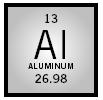Aluminum

MELTING POINT:
660.32°C
BOILING POINT
: 2,519°C
DENSITY
: 2.70 g/cm
3
MOST COMMON IONS
: Al
3+
Aluminum is a silvery-white metallic element discovered in 1825 by Danish chemist Hans Christian Ørsted. It is the most abundant metal found in Earth's crust, comprising 8.3 percent of the crust's total weight. Its content in seawater, however, is as low as 0.01 gram per metric ton (0.01 part per million). The key isotope of aluminum is 27 Al with a natural abundance of 100 percent, but seven other isotopes are known, one of which is used as a radioactive tracer ( 26 Al).
Aluminum is not found in its metallic state in nature; it is usually found as silicate, oxide, or hydrated oxide (bauxite). Its extraction from ore is difficult and expensive; aluminum is therefore commonly recycled, the energy of recycling being a mere 5 percent of the energy needed to extract the metal.
Aluminum is lightweight, ductile , and easily machined. It is protected by an oxide film from reacting with air and water, and is therefore rust-resistant. It is one of the lightest metals but is quite tough and most helpful in metallurgy , transportation (e.g., aircraft, automobiles, railroad cars, and boats), and architecture (e.g., window frames and decorative ornaments). It is also used in the manufacture of cooking gear because it is a good conductor of heat. Aluminum foils as thin as 0.18 millimeter (0.007 inch) are a household convenience, protecting food from spoiling and providing insulation. Aluminum-made beverage cans are widely manufactured; more than 100 billion are produced each year. The average human body contains about 35 milligrams (0.0012 ounce) of aluminum, but no known biological role has been established for it; it is, however, suspected to be a factor in the development of Alzheimer's disease.
SEE ALSO Electrochemistry .
Jean-Claude Bünzli
Bibliography
Altenpohl, Dietrich G., and Kaufman, J. G. (1998). ALUMINUM: Technology, Applications, and Environment (A Profile of a Modern Metal, Sixth edition). Washington, DC: Minerals, Metals and Materials Society.
Farndon, John (2001). Aluminum. Tarrytown, NY: Benchmark Books.
Comment about this article, ask questions, or add new information about this topic: